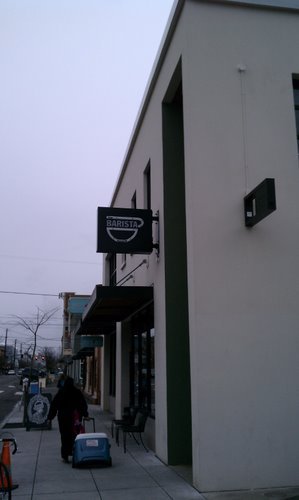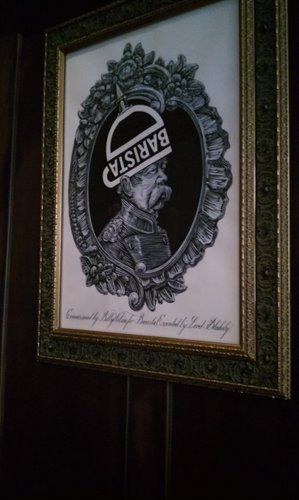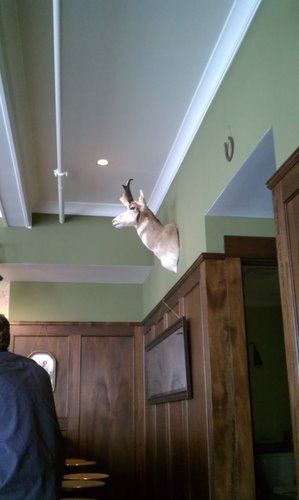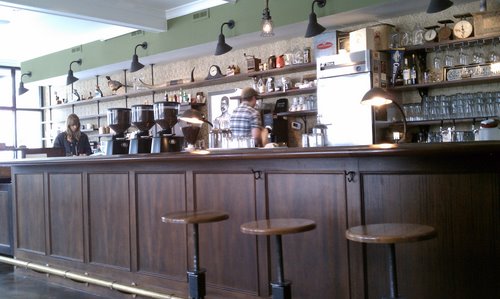Day 2 - Judgement Day
Brrriiiiingg! Brrriiiiingg! Brrriiiiingg!
My eyes popped open and I looked around, trying to figure out where I was. The room was still dark. What the hell? Will someone shut that bell off please?—I thought, half-dazed. Then I remembered—the bell was my 5:15 alarm going off. It was Thursday, January 26, and I was supposed to go to Tacoma for the 2012 Northwest Regional Barista Championships (NWRBC). Yawning, I rolled slowly out of bed, grabbed a quick breakfast and made my way to the bus stop by 5:50am.
The bus took me to meet Brandon Arends, who was driving us up to Tacoma. The NWRBC didn’t start until Friday, but we were going up a day early to get certified as judges for the competition. Over the last year, ever since we volunteered together at the 2011 NWRBC, Brandon has been trying to get me to try judging. For a long time, I was reluctant because I didn’t think I had enough relevant coffee experience. It’s one thing to regularly drink and write about coffee, and quite another to be working with it all the time. He finally convinced me though, which is why I found myself rolling up I-5 towards Tacoma at 6:15am.
I was a little nervous about the day ahead. I didn’t know what to expect at the training because I had waited until the last minute to register and never got the email with the day’s schedule and instructions. Brandon, who registered on time, had given me a little advice on Wednesday night, when we discussed our travel plans.
“Make sure you check out the rules and the score sheet,” he told me.
“I’ll do it,” I replied, not really intending to do much studying.
I should have heeded his warning a little more closely.
Tacoma – center of haute café (for a few days, at least)
The barista competition was once again being held at the Tacoma Convention Center in downtown Tacoma, where bail bonds shops outnumber specialty cafés. Since Tacoma is not the hotbed of coffee in the Northwest, you might wonder why the SCAA decided to hold its convention here two years in a row. I know I did.
Brandon suggested two reasons. First, Tacoma’s proximity to SEA-TAC airport makes it easy to travel there. Second, it would have been Portland’s turn to host, except that the city is hosting the United States Barista Championship in April. My theory is that if the Specialty Coffee Association of America (SCAA) held both competitions in Portland, it would be too openly admitting that Portland is the center of the universe when it comes to specialty coffee. Portlanders already know this to be true, but we wouldn’t want to hurt Seattle’s feelings.
Whatever the reason, the Tacoma Convention Center makes a good spot for the competition. It has lots of space, there’s free parking just a couple blocks away, and hotel rates in Tacoma are reasonable (late January is the low season for tourists in Tacoma).
Ready or not…
We scooted in through front doors at 9am and took our places at the only available seats in the room (the training was kind of like going to church—if you arrive late, you sit up front). The head judges welcomed everyone and introduced themselves before going over the protocol for becoming a judge. Each of the head judges had worked in the coffee industry and had years of experience judging competitions all over the world.
But what about the rest of us? What type of people are judges for barista competitions? Most of the people in the room worked full time in the coffee industry, as trainers, café managers, baristas, marketers—all types of roles.
However, not everyone had years of experience in the industry, so I didn’t feel as out of place as I thought I might. One woman was a writer from Seattle who was trying to learn more about coffee. Another woman had only worked in coffee for a year. She had never been to a competition before, but her manager encouraged her to come to judge.
After introductions, our teacher said it was time to take the certification test, and that we “have to get an 80% on the exams to get your certification to judge.”
Test?! Already? Eighty percent? I felt a whoosh of air around me as the test takers gasped in unison. Apparently, I wasn’t the only one who didn’t get the memo about knowing the rules beforehand. Could they really expect us to know how to judge before we got there?
Somewhere in the back of my mind, I recalled Brandon’s advice from the night before. At least I had read through the rules in the car on the ride up to Tacoma.
How much do you know?
I started down through the exam, which consisted of multiple-choice questions and fill-in-the-blank questions about both technical and sensory elements. The test took me nearly an hour to complete and covered the USBC rules and the official competition score sheet. It had questions like, “How do you judge the integrity of an espresso’s crema?” and “How thick does the foam on a cappuccino have to be for the drink to be eligible to receive a “Very Good” score?”
As I worked my way through the exam, I pictured myself back in college, sweating my way through an English literature exam I hadn’t prepared for. I employed every trick in the book I could think of, eliminating obviously incorrect answers and leafing through the different sections of the test for clues.
When everyone had finished the exam, we took a short break before resuming our training. Multiple people I talked to during the break were pessimistic about their results on the test.
It’s not getting easier
After we had been tested for our knowledge of the rules, we moved on to actually figuring out what made a good drink and what didn’t. One of the most difficult things about judging is to get all the judges to grade consistently between competitors. This process is known as calibration. The head judges showed us slides of what to look for when we looked at a good espresso crema (and a bad one). The crema is the foamy layer that sits on top of an espresso. It is formed when the steam is forced through the coffee grounds, emulsifying the oils inside.
In each slide, the crema looked a little different. We discussed how they differed and which deserved good scores and which did not. The session helped us better understand the official standards of the competition. We then took a quiz, looking at several photos of espressos of varying quality.
Just before the lunch break, we did a triangulation test to check our palates. I propose another name for it: the Sesame Street test (“one of these things is not like the other, one of these things just doesn’t belong…”). A triangulation test is an exercise where three coffees are set out on a table together. Two of them are the same and the other one is different. The testers sip each one and mark down which of the three is different.
If I felt fairly confident about the capabilities of my palate before Thursday, I finished the triangulation test wondering if I had ever tasted coffee before in my life. We did six groups of three, and I was confident about only two of the groups. The rest of them were similar enough that I ended up guessing. I figured I had failed the test and would end up washing dishes instead of judging.
Everyone seemed relieved when lunch was served. As we gathered around the buffet table, I overheard several people in shock at the difficulty of the triangulation test. I don’t know if it really helps to know you aren’t the only one struggling, but I know I felt a whole lot better after eating.
After lunch, the head judges gave us our test results. By some miracle, I had passed! I was relieved (the judges also passed around a new exam for those who needed to re-take it. It turns out the first test was not our only opportunity to become a judge—but we didn’t know that at the time).
The real calibration – testing drinks
When everyone had their tests done, the group finally got down to calibrating with real drinks. We went to the main hall where the three espresso machines had been set up for the competition. Technical judges grouped up at one machine, and the sensory judges divided into two groups and gathered around the other machines. Each machine was staffed by a barista who made us a variety of drinks. Our barista tried to vary the quality of the shots he made, attempting to make the calibration more like the competition.
We began by evaluating espressos. Espresso is the main focus of the Barista Championships. Espresso is the most difficult type of coffee to make well and make consistently. If a barista wants to score well, he or she needs to make great espresso, not only in the espresso course, but also in the cappuccino and signature beverage course. As the baristas pumped out the espressos, the trainers let us write down our impressions, helping us keep to the regulations in the rulebook.
The calibration was fun, but challenging. All of the judges who were new to the certification process were reluctant to make a definitive score for each of the drinks we tried. We would taste a drink then look to our trainer for guidance, instead of writing down the score we thought it deserved. After a while, when we had evaluated shot after shot and cappuccino after cappuccino, we began to get a pretty good sense of what was good according to standard and what was not.
Each drink gets the following scores. Unacceptable=0, Acceptable=1, Average=2, Good=3, Very Good=4, Excellent=5 or Extraordinary=6. You can give scores with half-point increments, but no scores of 0.5 are allowed, and the head judge must approve any scores of Extraordinary. As we practiced judging, we were encouraged to use the words instead of the numbers in order to accustom ourselves to the official scoring language. The language helped us score the drinks more accurately.
We finally finished up the calibration about quarter to six. The head judges sent us home and told us to be back at 11am the next morning. We were well-caffeinated and ready to go find some dinner. My fears about being judged unworthy to be a judge had not been realized. When we got the schedule for Friday, I was assigned to the first, third and fifth competitors. I knew I would be nervous, but thanks to our trainers, I felt confident that I would do a good job.
 Tuesday, March 20, 2012 at 3:55PM
Tuesday, March 20, 2012 at 3:55PM 






